Canadian vs Hungarian Community Comparison
COMPARE
Canadian
Hungarian
Social Comparison
Social Comparison
Canadians
Hungarians
7,303
SOCIAL INDEX
70.5/ 100
SOCIAL RATING
123rd/ 347
SOCIAL RANK
6,572
SOCIAL INDEX
63.2/ 100
SOCIAL RATING
149th/ 347
SOCIAL RANK
Hungarian Integration in Canadian Communities
The statistical analysis conducted on geographies consisting of 406,160,451 people shows a poor positive correlation between the proportion of Hungarians within Canadian communities in the United States with a correlation coefficient (R) of 0.122. On average, for every 1% (one percent) increase in Canadians within a typical geography, there is an increase of 0.017% in Hungarians. To illustrate, in a geography comprising of 100,000 individuals, a rise of 1,000 Canadians corresponds to an increase of 16.7 Hungarians.
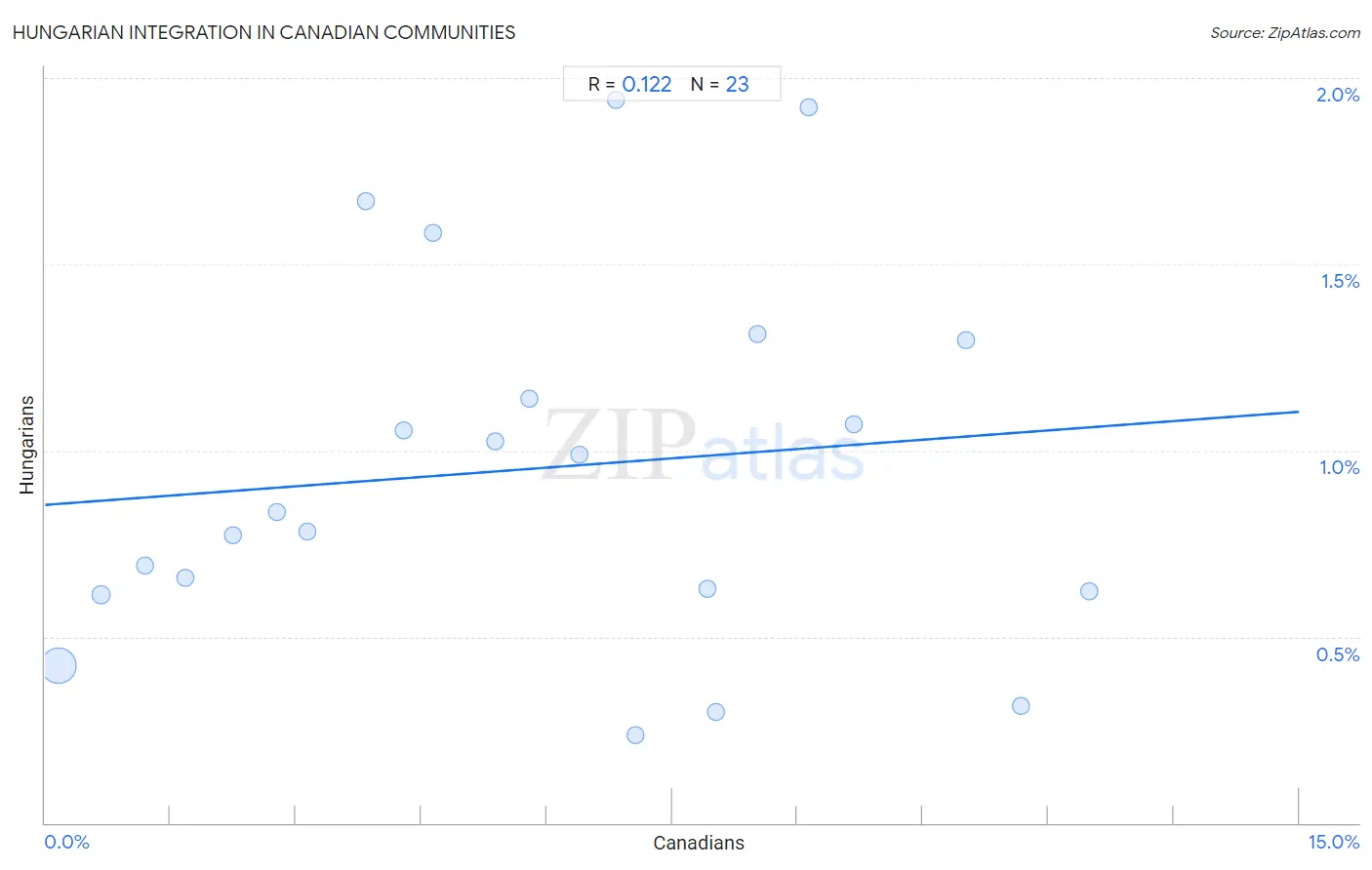
Canadian vs Hungarian Income
When considering income, the most significant differences between Canadian and Hungarian communities in the United States are seen in householder income under 25 years ($52,336 compared to $50,247, a difference of 4.2%), wage/income gap (28.1% compared to 29.0%, a difference of 3.1%), and median household income ($87,769 compared to $86,920, a difference of 0.98%). Conversely, both communities are more comparable in terms of median male earnings ($57,286 compared to $57,309, a difference of 0.040%), householder income ages 25 - 44 years ($97,625 compared to $97,544, a difference of 0.080%), and median earnings ($47,911 compared to $47,795, a difference of 0.24%).

| Income Metric | Canadian | Hungarian |
| Per Capita Income | Exceptional $45,858 | Excellent $45,426 |
| Median Family Income | Excellent $106,597 | Excellent $105,609 |
| Median Household Income | Excellent $87,769 | Good $86,920 |
| Median Earnings | Excellent $47,911 | Excellent $47,795 |
| Median Male Earnings | Exceptional $57,286 | Exceptional $57,309 |
| Median Female Earnings | Average $39,724 | Average $39,510 |
| Householder Age | Under 25 years | Average $52,336 | Tragic $50,247 |
| Householder Age | 25 - 44 years | Excellent $97,625 | Excellent $97,544 |
| Householder Age | 45 - 64 years | Excellent $104,560 | Excellent $103,913 |
| Householder Age | Over 65 years | Good $62,230 | Good $61,673 |
| Wage/Income Gap | Tragic 28.1% | Tragic 29.0% |
Canadian vs Hungarian Poverty
When considering poverty, the most significant differences between Canadian and Hungarian communities in the United States are seen in married-couple family poverty (4.5% compared to 5.3%, a difference of 17.0%), single father poverty (17.1% compared to 18.5%, a difference of 8.1%), and family poverty (8.2% compared to 8.8%, a difference of 7.4%). Conversely, both communities are more comparable in terms of single female poverty (21.1% compared to 21.1%, a difference of 0.37%), seniors poverty over the age of 75 (11.3% compared to 11.2%, a difference of 0.51%), and female poverty among 18-24 year olds (19.7% compared to 19.8%, a difference of 0.57%).
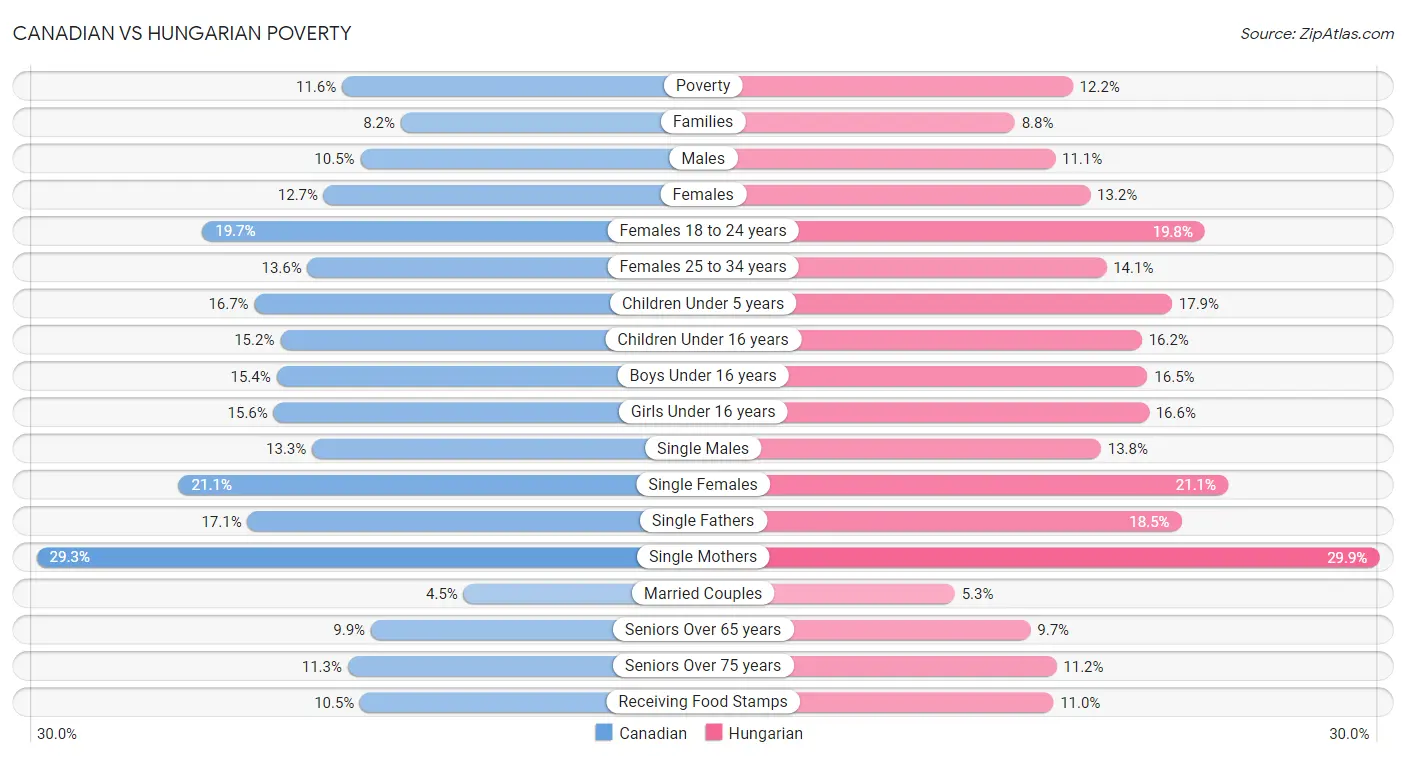
| Poverty Metric | Canadian | Hungarian |
| Poverty | Exceptional 11.6% | Good 12.2% |
| Families | Exceptional 8.2% | Good 8.8% |
| Males | Exceptional 10.5% | Average 11.1% |
| Females | Exceptional 12.7% | Good 13.2% |
| Females 18 to 24 years | Excellent 19.7% | Good 19.8% |
| Females 25 to 34 years | Average 13.6% | Poor 14.1% |
| Children Under 5 years | Good 16.7% | Poor 17.9% |
| Children Under 16 years | Excellent 15.2% | Average 16.2% |
| Boys Under 16 years | Exceptional 15.4% | Average 16.5% |
| Girls Under 16 years | Excellent 15.6% | Average 16.6% |
| Single Males | Tragic 13.3% | Tragic 13.8% |
| Single Females | Average 21.1% | Fair 21.1% |
| Single Fathers | Tragic 17.1% | Tragic 18.5% |
| Single Mothers | Average 29.3% | Poor 29.9% |
| Married Couples | Exceptional 4.5% | Fair 5.3% |
| Seniors Over 65 years | Exceptional 9.9% | Exceptional 9.7% |
| Seniors Over 75 years | Exceptional 11.3% | Exceptional 11.2% |
| Receiving Food Stamps | Exceptional 10.5% | Excellent 11.0% |
Canadian vs Hungarian Unemployment
When considering unemployment, the most significant differences between Canadian and Hungarian communities in the United States are seen in unemployment among seniors over 75 years (9.7% compared to 10.1%, a difference of 4.1%), unemployment among ages 60 to 64 years (4.7% compared to 4.9%, a difference of 3.7%), and unemployment among ages 45 to 54 years (4.3% compared to 4.5%, a difference of 3.7%). Conversely, both communities are more comparable in terms of unemployment among women with children under 6 years (7.8% compared to 7.8%, a difference of 0.060%), unemployment among youth under 25 years (11.4% compared to 11.4%, a difference of 0.080%), and unemployment among women with children under 18 years (5.3% compared to 5.3%, a difference of 0.13%).
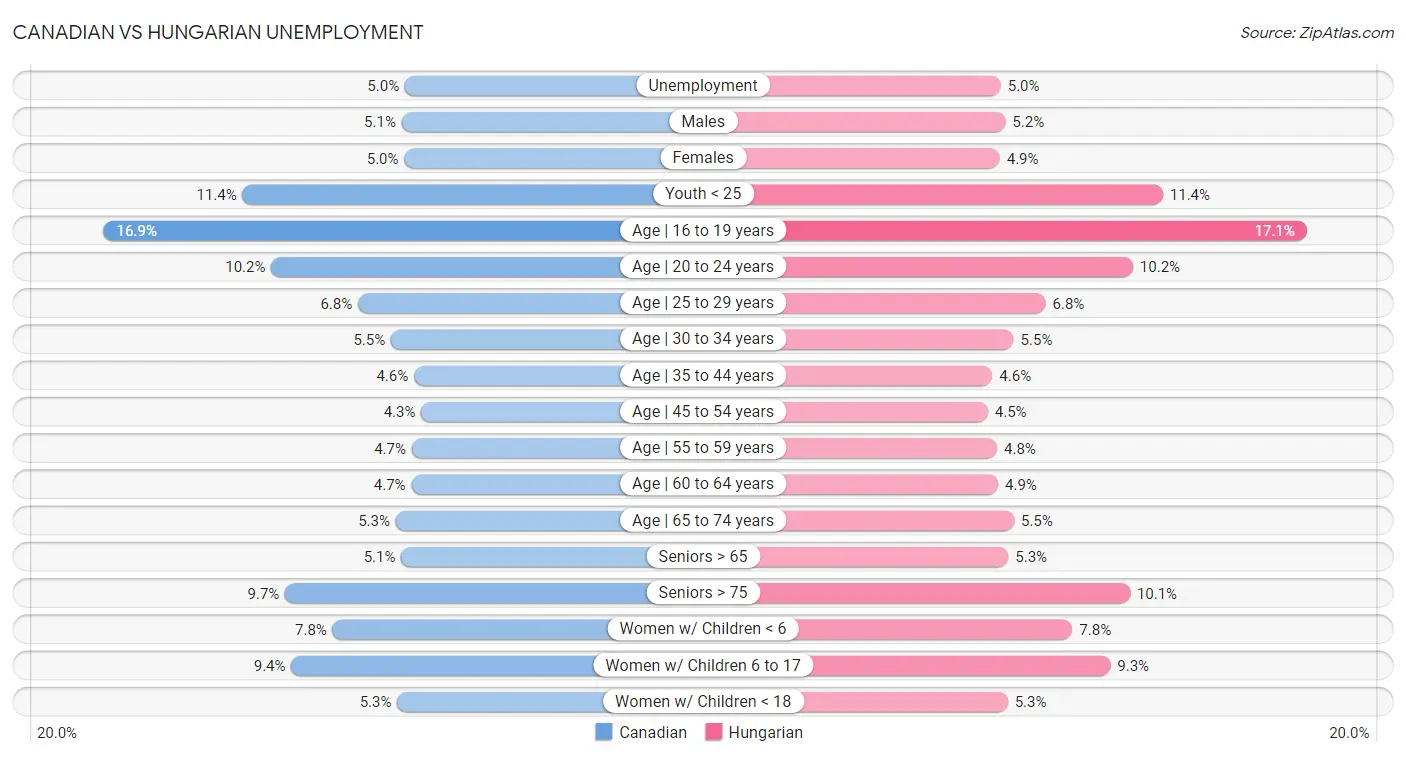
| Unemployment Metric | Canadian | Hungarian |
| Unemployment | Exceptional 5.0% | Exceptional 5.0% |
| Males | Exceptional 5.1% | Excellent 5.2% |
| Females | Exceptional 5.0% | Exceptional 4.9% |
| Youth < 25 | Excellent 11.4% | Excellent 11.4% |
| Age | 16 to 19 years | Exceptional 16.9% | Exceptional 17.1% |
| Age | 20 to 24 years | Good 10.2% | Good 10.2% |
| Age | 25 to 29 years | Poor 6.8% | Fair 6.8% |
| Age | 30 to 34 years | Fair 5.5% | Average 5.5% |
| Age | 35 to 44 years | Good 4.6% | Good 4.6% |
| Age | 45 to 54 years | Exceptional 4.3% | Good 4.5% |
| Age | 55 to 59 years | Exceptional 4.7% | Average 4.8% |
| Age | 60 to 64 years | Exceptional 4.7% | Average 4.9% |
| Age | 65 to 74 years | Good 5.3% | Tragic 5.5% |
| Seniors > 65 | Good 5.1% | Tragic 5.3% |
| Seniors > 75 | Tragic 9.7% | Tragic 10.1% |
| Women w/ Children < 6 | Fair 7.8% | Fair 7.8% |
| Women w/ Children 6 to 17 | Tragic 9.4% | Tragic 9.3% |
| Women w/ Children < 18 | Excellent 5.3% | Excellent 5.3% |
Canadian vs Hungarian Labor Participation
When considering labor participation, the most significant differences between Canadian and Hungarian communities in the United States are seen in in labor force | age 16-19 (40.1% compared to 39.8%, a difference of 0.61%), in labor force | age > 16 (64.1% compared to 63.8%, a difference of 0.52%), and in labor force | age 20-24 (76.6% compared to 76.3%, a difference of 0.39%). Conversely, both communities are more comparable in terms of in labor force | age 20-64 (79.1% compared to 79.2%, a difference of 0.010%), in labor force | age 35-44 (84.2% compared to 84.2%, a difference of 0.060%), and in labor force | age 25-29 (84.7% compared to 84.6%, a difference of 0.080%).

| Labor Participation Metric | Canadian | Hungarian |
| In Labor Force | Age > 16 | Tragic 64.1% | Tragic 63.8% |
| In Labor Force | Age 20-64 | Tragic 79.1% | Tragic 79.2% |
| In Labor Force | Age 16-19 | Exceptional 40.1% | Exceptional 39.8% |
| In Labor Force | Age 20-24 | Exceptional 76.6% | Exceptional 76.3% |
| In Labor Force | Age 25-29 | Average 84.7% | Average 84.6% |
| In Labor Force | Age 30-34 | Poor 84.4% | Fair 84.5% |
| In Labor Force | Age 35-44 | Poor 84.2% | Fair 84.2% |
| In Labor Force | Age 45-54 | Poor 82.4% | Fair 82.7% |
Canadian vs Hungarian Family Structure
When considering family structure, the most significant differences between Canadian and Hungarian communities in the United States are seen in single father households (2.3% compared to 2.2%, a difference of 4.9%), single mother households (5.9% compared to 5.7%, a difference of 4.4%), and divorced or separated (12.4% compared to 12.0%, a difference of 3.3%). Conversely, both communities are more comparable in terms of family households (64.4% compared to 64.9%, a difference of 0.69%), currently married (48.3% compared to 48.8%, a difference of 1.1%), and average family size (3.14 compared to 3.18, a difference of 1.3%).

| Family Structure Metric | Canadian | Hungarian |
| Family Households | Good 64.4% | Exceptional 64.9% |
| Family Households with Children | Tragic 27.1% | Good 27.6% |
| Married-couple Households | Exceptional 48.2% | Exceptional 49.1% |
| Average Family Size | Tragic 3.14 | Tragic 3.18 |
| Single Father Households | Good 2.3% | Exceptional 2.2% |
| Single Mother Households | Exceptional 5.9% | Exceptional 5.7% |
| Currently Married | Exceptional 48.3% | Exceptional 48.8% |
| Divorced or Separated | Tragic 12.4% | Good 12.0% |
| Births to Unmarried Women | Average 31.9% | Good 31.2% |
Canadian vs Hungarian Vehicle Availability
When considering vehicle availability, the most significant differences between Canadian and Hungarian communities in the United States are seen in no vehicles in household (8.3% compared to 9.9%, a difference of 19.2%), 4 or more vehicles in household (6.9% compared to 6.4%, a difference of 7.1%), and 3 or more vehicles in household (21.0% compared to 19.8%, a difference of 5.9%). Conversely, both communities are more comparable in terms of 1 or more vehicles in household (91.8% compared to 90.3%, a difference of 1.6%), 2 or more vehicles in household (58.6% compared to 56.5%, a difference of 3.7%), and 3 or more vehicles in household (21.0% compared to 19.8%, a difference of 5.9%).

| Vehicle Availability Metric | Canadian | Hungarian |
| No Vehicles Available | Exceptional 8.3% | Excellent 9.9% |
| 1+ Vehicles Available | Exceptional 91.8% | Excellent 90.3% |
| 2+ Vehicles Available | Exceptional 58.6% | Excellent 56.5% |
| 3+ Vehicles Available | Exceptional 21.0% | Good 19.8% |
| 4+ Vehicles Available | Exceptional 6.9% | Good 6.4% |
Canadian vs Hungarian Education Level
When considering education level, the most significant differences between Canadian and Hungarian communities in the United States are seen in no schooling completed (1.7% compared to 1.6%, a difference of 5.1%), doctorate degree (2.0% compared to 1.9%, a difference of 4.7%), and college, 1 year or more (60.6% compared to 59.5%, a difference of 1.9%). Conversely, both communities are more comparable in terms of nursery school (98.4% compared to 98.5%, a difference of 0.080%), kindergarten (98.4% compared to 98.5%, a difference of 0.080%), and 1st grade (98.3% compared to 98.4%, a difference of 0.080%).
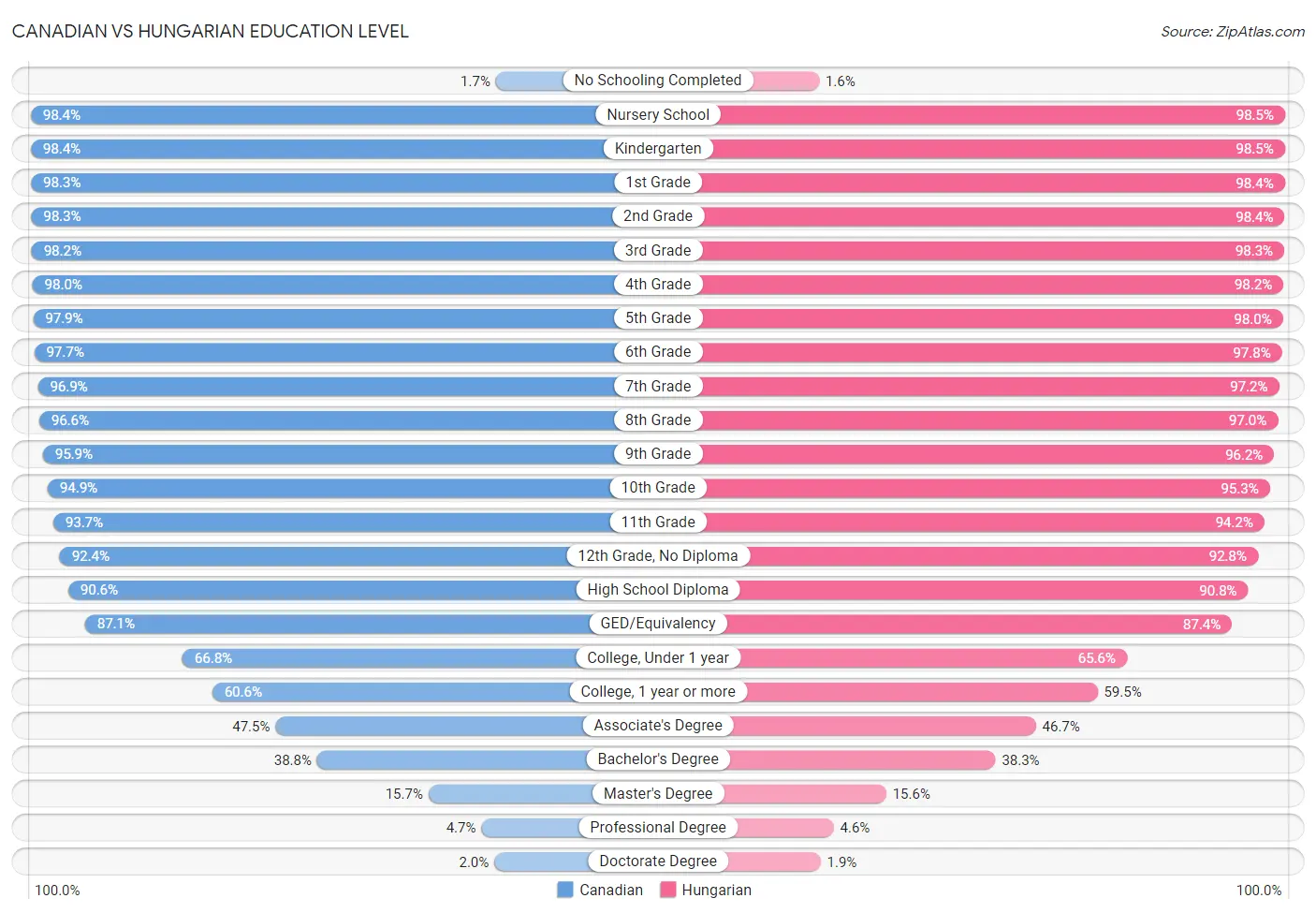
| Education Level Metric | Canadian | Hungarian |
| No Schooling Completed | Exceptional 1.7% | Exceptional 1.6% |
| Nursery School | Exceptional 98.4% | Exceptional 98.5% |
| Kindergarten | Exceptional 98.4% | Exceptional 98.5% |
| 1st Grade | Exceptional 98.3% | Exceptional 98.4% |
| 2nd Grade | Exceptional 98.3% | Exceptional 98.4% |
| 3rd Grade | Exceptional 98.2% | Exceptional 98.3% |
| 4th Grade | Exceptional 98.0% | Exceptional 98.2% |
| 5th Grade | Exceptional 97.9% | Exceptional 98.0% |
| 6th Grade | Exceptional 97.7% | Exceptional 97.8% |
| 7th Grade | Exceptional 96.9% | Exceptional 97.2% |
| 8th Grade | Exceptional 96.6% | Exceptional 97.0% |
| 9th Grade | Exceptional 95.9% | Exceptional 96.2% |
| 10th Grade | Exceptional 94.9% | Exceptional 95.3% |
| 11th Grade | Exceptional 93.7% | Exceptional 94.2% |
| 12th Grade, No Diploma | Exceptional 92.4% | Exceptional 92.8% |
| High School Diploma | Exceptional 90.6% | Exceptional 90.8% |
| GED/Equivalency | Exceptional 87.1% | Exceptional 87.4% |
| College, Under 1 year | Excellent 66.8% | Average 65.6% |
| College, 1 year or more | Excellent 60.6% | Average 59.5% |
| Associate's Degree | Good 47.5% | Average 46.7% |
| Bachelor's Degree | Good 38.8% | Good 38.3% |
| Master's Degree | Excellent 15.7% | Good 15.6% |
| Professional Degree | Excellent 4.7% | Excellent 4.6% |
| Doctorate Degree | Exceptional 2.0% | Good 1.9% |
Canadian vs Hungarian Disability
When considering disability, the most significant differences between Canadian and Hungarian communities in the United States are seen in disability age under 5 (1.5% compared to 1.5%, a difference of 5.0%), hearing disability (3.5% compared to 3.4%, a difference of 3.0%), and vision disability (2.2% compared to 2.1%, a difference of 2.8%). Conversely, both communities are more comparable in terms of disability age over 75 (46.6% compared to 46.5%, a difference of 0.10%), ambulatory disability (6.3% compared to 6.3%, a difference of 0.19%), and self-care disability (2.5% compared to 2.5%, a difference of 0.64%).
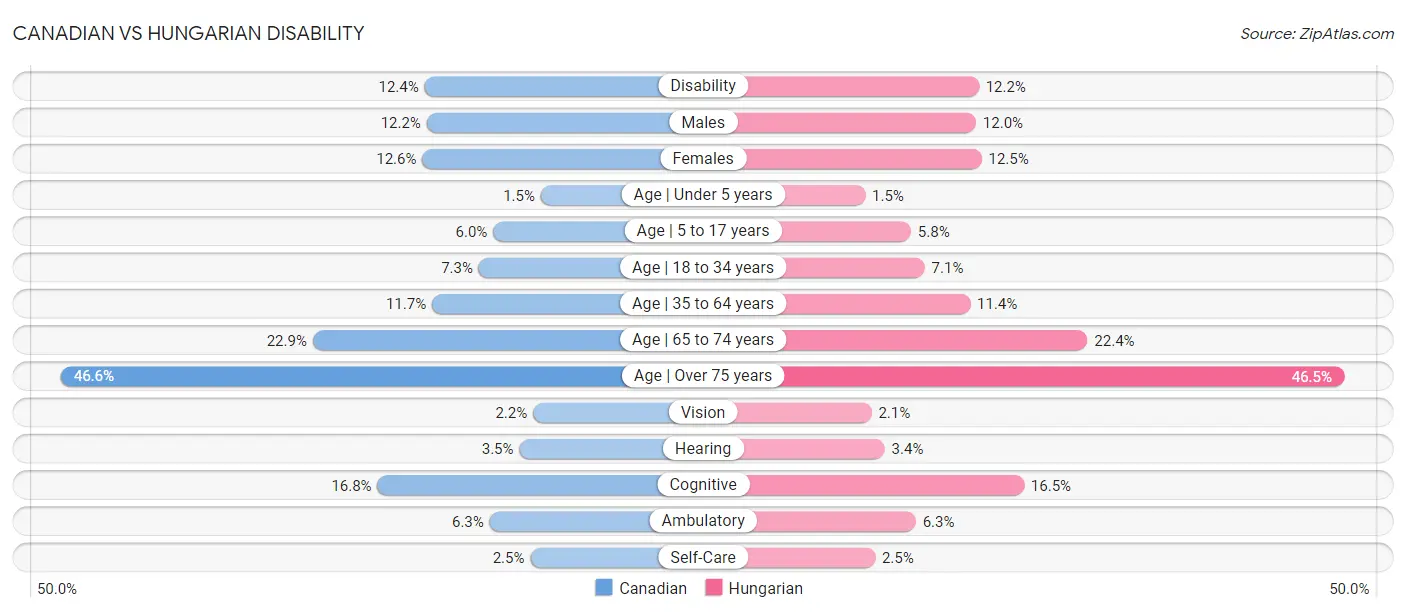
| Disability Metric | Canadian | Hungarian |
| Disability | Tragic 12.4% | Tragic 12.2% |
| Males | Tragic 12.2% | Tragic 12.0% |
| Females | Tragic 12.6% | Tragic 12.5% |
| Age | Under 5 years | Tragic 1.5% | Tragic 1.5% |
| Age | 5 to 17 years | Tragic 6.0% | Tragic 5.8% |
| Age | 18 to 34 years | Tragic 7.3% | Tragic 7.1% |
| Age | 35 to 64 years | Poor 11.7% | Fair 11.4% |
| Age | 65 to 74 years | Good 22.9% | Exceptional 22.4% |
| Age | Over 75 years | Exceptional 46.6% | Exceptional 46.5% |
| Vision | Fair 2.2% | Good 2.1% |
| Hearing | Tragic 3.5% | Tragic 3.4% |
| Cognitive | Exceptional 16.8% | Exceptional 16.5% |
| Ambulatory | Poor 6.3% | Tragic 6.3% |
| Self-Care | Average 2.5% | Average 2.5% |